THIRD IN A SERIES of preliminary reports
(Translated to Imperial Gothic from High Mahaduyanan)
++MEMORANDUM TO: [REDACTED], Ordo Astartes++
++FROM: Inquisitor Varman Kumar++
++DATE: 0451023.M42++
PER YOUR DIRECTIVE, I am conducting a multi-year investigation of the Adeptus Astartes Chapter known as the “Fighting Tigers of Veda,” to include their successor chapter, the “Sabretooth Tigers of Veda.” Unless otherwise indicated, I will use the term “Fighting Tigers” in this report to refer to both organizations. For your reference, please see my previous memoranda at the datalinks below:
What follows is my report on the Fighting Tigers’ organizational structure.

Fighting Tiger Organization
The Fighting Tigers do not organize themselves into 10 companies, as do Chapters who adhere strictly to the Codex Astartes (such as the Ultramarines). As an extension of the native culture that the Tigers adopted, they organize instead into five sabhas, or associations, of similar warriors, and each sabha names themselves for the ancient Vedic god they venerate. The five sabhas are:
- Tigers of Indra: Terminator Squads, Sternguard Squads, Vanguard Squads; Primaris Marines;
- Tigers of Rudra: Tactical Marine Squads, Land Speeder crews;
- Tigers of Kali: Assault Marine Squads, Space Marine Bike Squads, and Attack Bike Squads;
- Tigers of Agni: Devastator Marine Squads, Heavy Support vehicle crews; and,
- Tigers of Puchan: Scout Squads and Scout Biker Squads.
Barring casualties, squads within each sabha are of a fixed size and membership, to promote standardization and cohesion. Sabhas contain not only Marines, but also the vehicles they use; the Fighting Tigers give each machine larger than a bike a name and consider those vehicles members as well. Fighting Tiger squads usually number 5 or 10 members, as the numbers 6, 7, 8, and 9 are favored by the forces of Chaos.
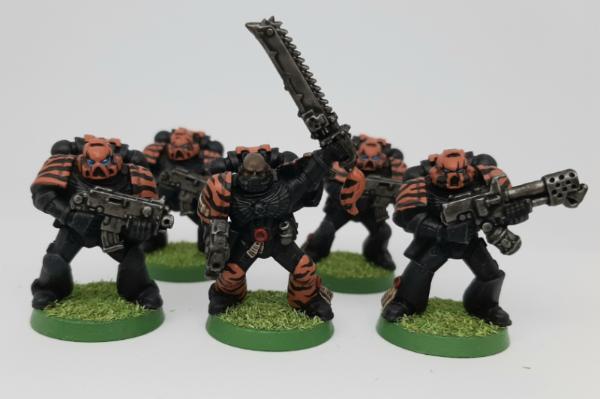
The organizational philosophy used by the Fighting Tigers is that sabhas are pools from which leaders can draw when assembling a campaign army. Unlike Codex Astartes Space Marine Companies, individual sabhas are not intended to effectively operate independently. By having pools of units, Fighting Tiger leaders (called tanadars–see below) can, for example, call upon many Assault and Devastator Squads when battling tank armies, or extra Tactical and Veteran units when facing hordes of infantry.
CONFIRMED FALSE: Previous accounts of the Fighting Tigers of Veda asserted that they had divided the Chapter into two castes, or Jatis, one based on each of Veda’s continents, to better patrol and defend their large and mostly unsettled homeworld. Each Jatis was equivalent in size (about 500 Marines, plus attendants) and organization, taking its name from its home continent (Mahaduyana or Ghuyarashtra), and its markings from the tigers found there. My research disputes this. While there are, indeed, two factions of Adeptus Astartes on the planet—one based in the north, the other in the south—they are two distinct Chapters. The Space Marines of “Jatis Mahaduyana” are the actual Fighting Tigers of Veda; those of “Jatis Ghuyarashtra” belong to its successor Chapter, the Sabretooth Tigers of Veda, established shortly after the former took control of the planet. Because the two Chapters have so often coordinated missions, and bear similar heraldry, outsiders have mistakenly believed that they belong to the same organization.
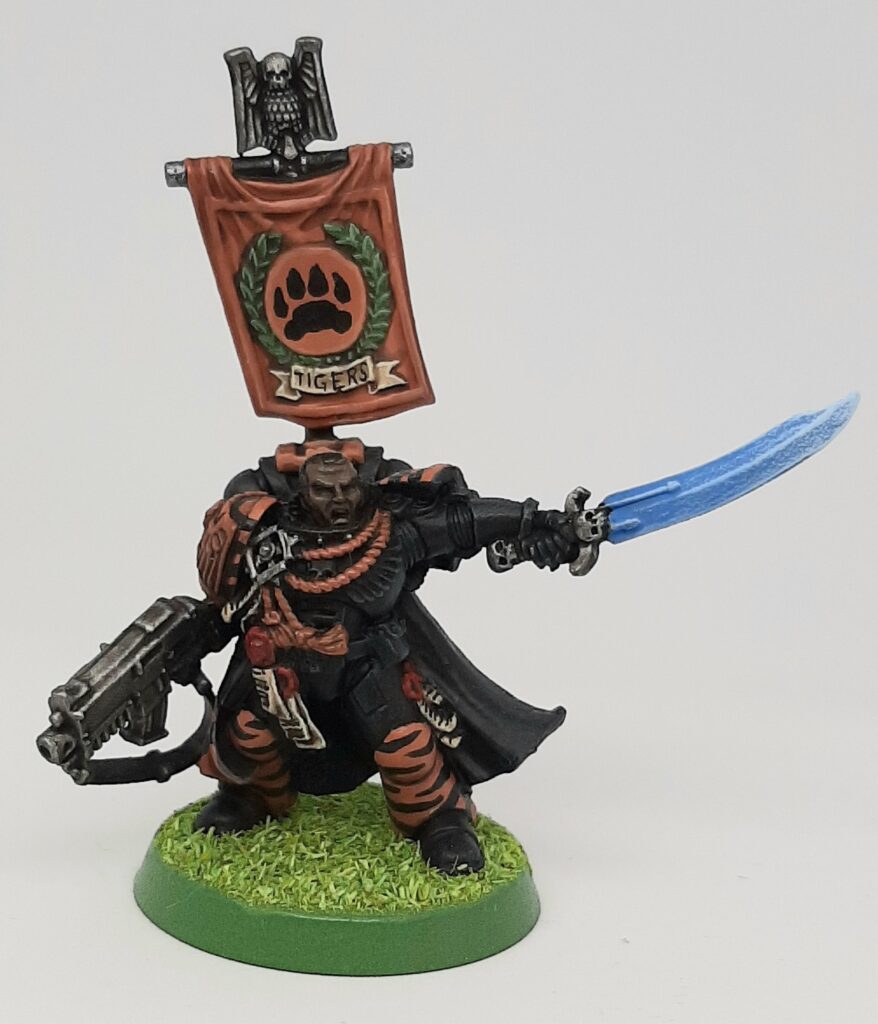
Fighting Tiger Tanadars
Sabhas are led into battle by tanadars, which, roughly translated into Imperial Gothic, means “officer.” To the Vedic people, however, the term means more than a military rank. The true tanadar is a warrior/ philosopher/ poet, wise beyond their years and learned in many subjects, who is as generous and chivalrous as he is fearsome in battle.
Tanadars are ardent defenders of the ancient Vedic traditions and are believed to speak directly to the thousands of Vedic gods, including the all-important patron deities of the Fighting Tigers:
- patient Brihaspati, god of wisdom and Librarians;
- stalwart Varuna, god of oaths and Chaplains;
- merciful Savitri, god of healing and Techmarines;
- clever Tvashtri, god of artifice and Apothecaries;
- wrathful Rudra, god of battles and Tactical Marines;
- all-seeing Puchan, god of guides and Scouts;
- fearsome Kali, the death-goddess of slaughter and Assault Marines;
- eternal Agni, god of fire and Devastator Marines; and
- peerless Indra, who leads the gods against the demons of Chaos. He is the patron of Captains and elite Fighting Tiger forces, including Primaris Marines.
Tanadars may be Captains and Lieutenants (called Kshatriyas) and their associated Command Squads (called Singh Squads). Each of the five sabhas has one Kshatriya, to lead it. A Kshatriya assigns squads to forces, instructs junior officers in strategy and tactics, and often heads campaign armies against the Imperium’s enemies.
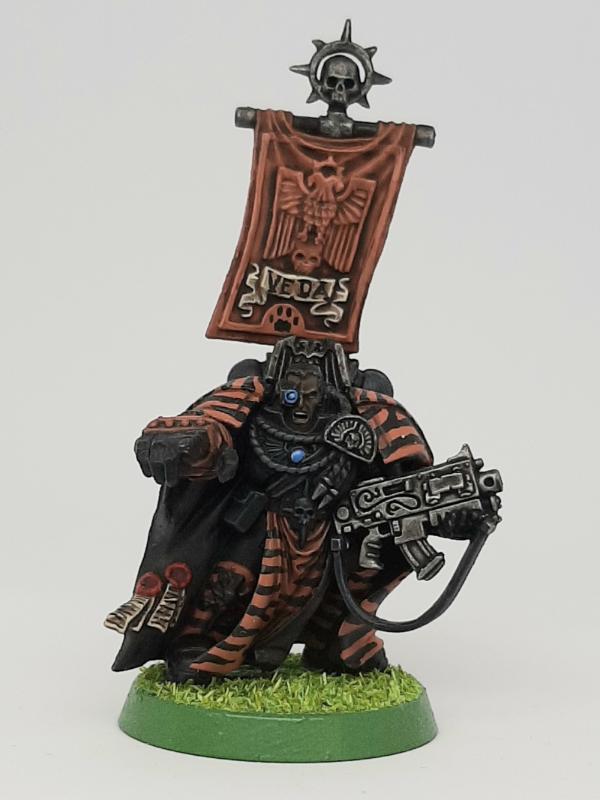
Tanadars may also be Librarians, Chaplains, etc. These tanadars do not wear the colors dictated by the Codex Astartes, but instead bear their Chapter’s colors, with a few markings to to denote their status. Tigers of Brihaspati (Librarians) bear the horned skull on their right shoulder plate, in place of tiger stripes. Tigers of Varuna (Chaplains) wear a white, skull-shaped helmet. Tigers of Tvashtri (Techmarines) bear the sign of the Adeptus Mechanicus on their right shoulder plates, and so on.
"Harijan," or "Gray Tigers." Fighting Tigers are bound by sacred vows and millennia of Vedic tradition. While some small infractions are to be expected (particularly during the early part of a Fighting Tiger's service), serious or deliberate violations may result in exile from the Chapter. These disgraced Tigers are deemed harijan,or "untouchable." A Fighting Tiger's training in religion and philosophy is strict, and in a century, perhaps only two or three would become Harijan. Thus, no more than a handful of Gray Tigers exist at any one time. The Harijan are sent to live alone as best they can on Veda, but before they go, they are supplied with a suit of gray armor (hence the name), a weapon, and a small amount of ammunition. If they ever expect to redeem themselves, they must make up for what they have done (or failed to do) through heroic deeds. Sometimes, Gray Tigers are inspired by mystic visions, leading them to gather against the foulest enemies of Veda. While a unit of Gray Tigers may appear on the same battlefield as the Fighting Tigers, they are offered no support or assistance. However, if they acquit themselves well in battle, they are usually restored to the Chapter (albeit posthumously, in many cases).

Current Chapter Masters
Veda has always been astrographically and culturally isolated from the Imperium, and the Great Rift (Cicatrix Maledictum) has furthered this isolation. So, too, with the Fighting Tigers. Information is scant on their recent activities, hierarchies, and leaders, to include even their Chapter Masters (each known by the title Raja).
What is known is that near the end of M42, Raja Shamhiir Taletri of the Sabretooth Tigers was removed from office after a disastrous confrontation with the T’au Empire. Supposedly, he was replaced by Raja Rama Ayodhya, but Rama (also called “The Exalted Prince”) was known to have led the Chapter during M38, and his Holy Grand Tomb on Veda is still a site of pilgrimages. Despite the Vedic belief in reincarnation, clearly, the current “Rama Ayodhya” must merely have taken the great hero’s name.
In a similar vein–and even more curious–is the information I have received that Shiva Naguradiku has resumed leadership of the Fighting Tigers. Shiva was the Chapter Master at the Tigers’ founding in late M34, earning the title of Maharaja after defeating the Drukhari that had occupied Veda. Crippled in early M35 when the Heretic Astartes Warband Bloodcomet attacked Veda, Shiva was placed in Dreadnought armor. That he has again taken up leadership of the Fighting Tigers merits further investigation, which I will undertake.
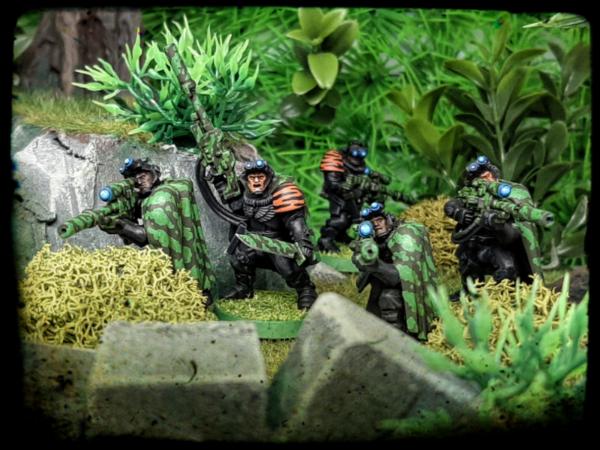
The Shikars
Recently, to address multiple threats, the Fighting Tigers, the Sabretooth Tigers, and a third contingent–the “White Tigers”–have reportedly coordinated efforts and assembled several very large armies, or Shikars (literally, “Hunts”). These are autonomous, self-contained forces analogous to the Crusades of the Black Templars. While most were formed from a single Chapter, some Shikars have a mix of personnel from two or even all three factions.
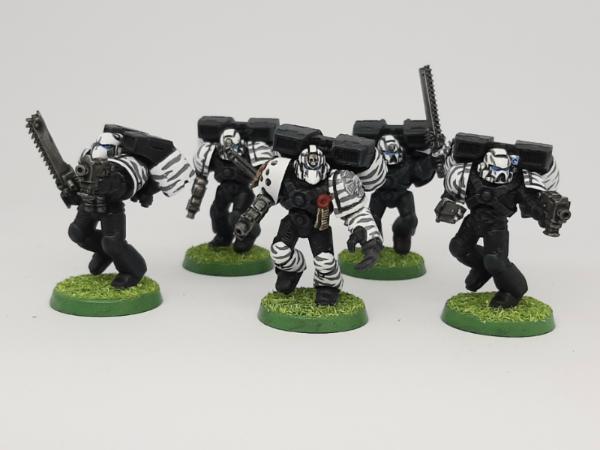
Leaving Veda to be guarded by its native Planetary Defense Force (the “Vedic Tiger Warriors”), these Shikars have set out across the galaxy. Their missions and whereabouts are unknown, as is how long they will remain active. It remains to be seen if they will ever return to Veda.
My investigations are ongoing, and more reports will be forthcoming. The next one will address these “White Tigers,” and the persistant lie that the Fighting Tigers of Veda somehow employ “female Space Marines.” Please contact me by the usual channels if you have follow-up questions or concerns.
Ave Imperator!
Varman Kumar, Inquisitor
Kenton Kilgore writes killer SF/F for young adults and adults who are still young. The Fighting Tigers of Veda appear in his latest novel, Stray Cats, which you can find here.

Check him out on kentonkilgore.com, and follow Kenton on Facebook for frequent posts on sci-fi, fantasy, and other speculative fiction. You can also catch him on Instagram, and find his books in softcover and for Kindle on Amazon.
